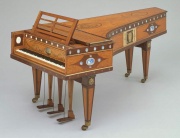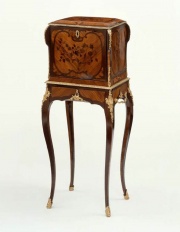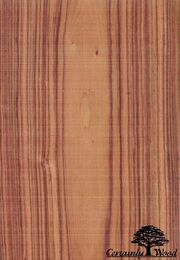Difference between revisions of "Tulipwood"
Jump to navigation
Jump to search
m (Text replace - "== Authority ==" to "== Sources Checked for Data in Record ==") |
|||
| Line 1: | Line 1: | ||
| − | [[File:1985.924-SC14552.jpg|thumb|]] | + | [[File:1985.924-SC14552.jpg|thumb|Grand piano<br>MFA#1985.924]] |
== Description == | == Description == | ||
| − | + | [[File:65.2504-C25964CR-d1.jpg|thumb|Jewelry cabinet<br>MFA# 65.2504]] | |
| − | A high quality, dense, figured wood from the Brazilian tulipwood tree Dalbergia | + | A high quality, dense, figured wood from the Brazilian tulipwood tree ''Dalbergia decipularis.'' The name tulipwood has also been given to numerous other similar hardwoods obtained from Myrtales trees native to the Americas, such as ''Dalbergia frutescens'' (Central and South America), Physocalymma scaberrima (Brazil), and Harpullia pendula (North America). Tulipwood is used in veneers, fine furniture, inlay, marquetry, musical instruments (percussion), and small novelty items. |
| − | + | [[File:tulipwoodwc.jpg|thumb|Tulipwood (''Dalbergia frutescens'')]] | |
== Synonyms and Related Terms == | == Synonyms and Related Terms == | ||
| − | Tulip lancewood; tulip tree; pau rosa; bois de rose; pinkwood; pau de fuso; jacaranda rosa; '' | + | Tulip lancewood; tulip tree; pau rosa; bois de rose; pinkwood; pau de fuso; jacaranda rosa; ''Dalbergia decipularis; Dalbergia frutescens''; ''Physocalymma scaberrima; Harpullia pendula''; palisandro (Esp.) |
| − | |||
| − | |||
| − | |||
| − | |||
| − | |||
| − | |||
| − | |||
| − | |||
| − | |||
| − | |||
| − | |||
| − | |||
| − | |||
| + | ==Physical and Chemical Properties== | ||
| + | * Heartwood is streaked with yellows, reds, oranges, and pinks; Color and figure can be highly variegated | ||
| + | * Pores are open and medium-sized; Grain is usually straight, with a fine texture. | ||
| + | * Wood is resistant to insects but not decay | ||
| + | * Density = 60 ppcf | ||
| − | == | + | ==Working Properties== |
| + | * Cab be difficult to work due to its high density; also has a blunting effect on cutters | ||
| + | * Can be difficult to glue do to an abundance of natural oils and high density | ||
| + | * Turns very well and takes a high polish | ||
| + | ==Resources and Citations== | ||
| + | * The Wood Database: [https://www.wood-database.com/brazilian-tulipwood/ Brazilian Tulipwood] | ||
* G.S.Brady, ''Materials Handbook'', McGraw-Hill Book Co., New York, 1971 Comment: p. 825 | * G.S.Brady, ''Materials Handbook'', McGraw-Hill Book Co., New York, 1971 Comment: p. 825 | ||
| Line 30: | Line 27: | ||
* George Savage, ''Art and Antique Restorer's Handbook'', Rockliff Publishing Corp, London, 1954 | * George Savage, ''Art and Antique Restorer's Handbook'', Rockliff Publishing Corp, London, 1954 | ||
| − | * Wikipedia | + | * Wikipedia: http://en.wikipedia.org/wiki/Tulipwood (Accessed Oct. 3, 2005) |
[[Category:Materials database]] | [[Category:Materials database]] | ||
Latest revision as of 11:37, 29 September 2022
Description
A high quality, dense, figured wood from the Brazilian tulipwood tree Dalbergia decipularis. The name tulipwood has also been given to numerous other similar hardwoods obtained from Myrtales trees native to the Americas, such as Dalbergia frutescens (Central and South America), Physocalymma scaberrima (Brazil), and Harpullia pendula (North America). Tulipwood is used in veneers, fine furniture, inlay, marquetry, musical instruments (percussion), and small novelty items.
Synonyms and Related Terms
Tulip lancewood; tulip tree; pau rosa; bois de rose; pinkwood; pau de fuso; jacaranda rosa; Dalbergia decipularis; Dalbergia frutescens; Physocalymma scaberrima; Harpullia pendula; palisandro (Esp.)
Physical and Chemical Properties
- Heartwood is streaked with yellows, reds, oranges, and pinks; Color and figure can be highly variegated
- Pores are open and medium-sized; Grain is usually straight, with a fine texture.
- Wood is resistant to insects but not decay
- Density = 60 ppcf
Working Properties
- Cab be difficult to work due to its high density; also has a blunting effect on cutters
- Can be difficult to glue do to an abundance of natural oils and high density
- Turns very well and takes a high polish
Resources and Citations
- The Wood Database: Brazilian Tulipwood
- G.S.Brady, Materials Handbook, McGraw-Hill Book Co., New York, 1971 Comment: p. 825
- F. H. Titmuss, Commercial Timbers of the World, The Technical Press Ltd., London, 1965
- George Savage, Art and Antique Restorer's Handbook, Rockliff Publishing Corp, London, 1954
- Wikipedia: http://en.wikipedia.org/wiki/Tulipwood (Accessed Oct. 3, 2005)


